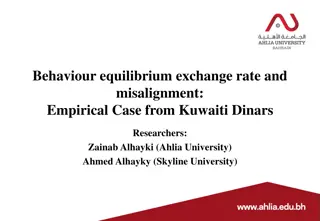Insights into Solar Wind Charge Exchange in the Solar System
Exploring the intricacies of solar wind charge exchange within the solar system, this content delves into plasma interactions, forbidden lines, and the unique environments provided by comets. Discussions on spatial and temporal variations, neutral chemical compositions, and spectroscopic analyses shed light on the fascinating phenomena surrounding solar wind interactions.
Download Presentation

Please find below an Image/Link to download the presentation.
The content on the website is provided AS IS for your information and personal use only. It may not be sold, licensed, or shared on other websites without obtaining consent from the author. Download presentation by click this link. If you encounter any issues during the download, it is possible that the publisher has removed the file from their server.
E N D
Presentation Transcript
Dennis Bodewits Diagnostics of solar wind charge exchange 2020-08 AtomDB workshop dennis@auburn.edu
Charge exchange Solar wind 1-2 MK plasma Collisionless 250 1000 km/s variable <1.5 KeV Simple molecules Forbidden lines
Solar wind charge exchange in the solar system Swift UVOT +XRT observations of Comet Lulin; Bodewits et al. 2012, Carter et al. 2012, APOD 2009/02/21 Bhardwaj et al. 2007 ; Dennerl et al. 2012; Branduardi et al. 2017
ESA/ China Solar Wind Magnetosphere Ionosphere Link Explorer (SMILE) http://sites.bu.edu/cupid/ https://sci.esa.int/web/smile/-/59312-science-with-smile
Planets! Comets! Our space telescopes! Ugh, this is so NASA Ooh, solar wind! \_( )_/ Wait, fusion??
Comets are cool! Comets provide different environments Move around solar system (rh, latitude) Activity levels (collisionally thick/thin) Spatial: Comets are extended sources Plasma interaction regions Neutral distribution Temporal variation Comet outbursts Solar wind variations (CMEs, flares, shocks) Spectroscopy Solar wind origins (freeze in temperature) Forbidden lines: astronomical lab Neutral chemical composition (H2O, CO2, CO, ..) Dust?
Comets are cool! Comets provide different environments Move around solar system (rh, latitude) Activity levels (collisionally thick/thin) Spatial: Comets are extended sources Plasma interaction regions Neutral distribution Temporal variation Comet outbursts Solar wind variations (CMEs, flares, shocks) Spectroscopy Solar wind origins (freeze in temperature) Forbidden lines: astronomical lab Neutral chemical composition (H2O, CO2, CO, ..) Dust? Lisse et al. 2005
ESA/Rosetta Comets are cool! Comets provide different environments Move around solar system (rh, latitude) Activity levels (collisionally thick/thin) Spatial: Comets are extended sources Plasma interaction regions Neutral distribution Temporal variation Comet outbursts Solar wind variations (CMEs, flares, shocks) Spectroscopy Solar wind origins (freeze in temperature) Forbidden lines: astronomical lab Neutral chemical composition (H2O, CO2, CO, ..) Dust? ESA/NASA SOHO
C+N OVII OVIII Comets are cool! Comets provide different environments Move around solar system (rh, latitude) Activity levels (collisionally thick/thin) Spatial: Comets are extended sources Plasma interaction regions Neutral distribution Temporal variation Comet outbursts Solar wind variations (CMEs, flares, shocks) Spectroscopy Solar wind origins (freeze in temperature) Forbidden lines: astronomical lab Neutral chemical composition (H2O, CO2, CO, ..) Dust? Solar wind freeze-in Temperature Bodewits et al. A&A 2007
Comets are cool! Comets provide different environments Move around solar system (rh, latitude) Activity levels (collisionally thick/thin) Spatial: Comets are extended sources Plasma interaction regions Neutral distribution Temporal variation Comet outbursts Solar wind variations (CMEs, flares, shocks) Spectroscopy Solar wind origins (freeze in temperature) Forbidden lines: astronomical lab Neutral chemical composition (H2O, CO2, CO, ..) Dust? Bockelee-Morvan et al. 2017
OVII emission from different electron donors Kronos package; O7+ + x O6+* @ 311 km/s (Mullen et al. 2017) K f H2O CO2 O Difference relative strength fir Different K-series K i K K r CO2, CO, C: similar fir, K- strong H2O, H, OH, O: stronger f, K- strong K K
XMM-RGS spectrum of Mars Halo CO2: similar fir, K- strong H2O, O: stronger f, K- strong f K- Journal of Geophysical Research: Planets, Volume: 122, Issue: 12, Pages: 2401-2428, First published: 08 November 2017, DOI: (10.1002/2017JE005336) Dennerl et al. 2006, A&A http://www.lpl.arizona.edu/~hubbard/Pty S206/Lectures3/Mar06.htm Why is the K-d strong? atomic oxygen! Wikipedia
Thank you! dennis@auburn.edu Don t miss: 10:45: Emanuele Bonamente, Charge exchange from comets with NICER 10:50: Steve Bromley, COLTRIMS of bare highly charged ions and simple molecules























